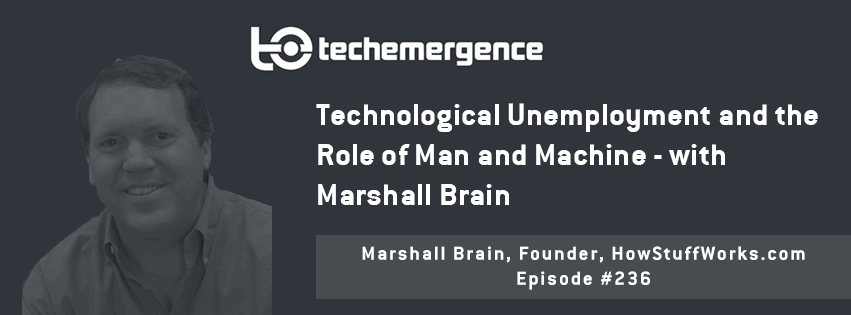Episode summary: Marshall Brain discusses how wetware (the human brain) is increasingly becoming a part of a bigger system which may in itself be managed by software systems. The roles and relationships of humans and machines are rapidly changing. With the increasing advances in technology, there are fewer and fewer skills or activities that an enterprise needs from human beings, and they only need those until they can be replaced by software or hardware.
For example, computer vision systems are often still not as effective as the human eye, so we still need human vision systems to recognize text or to recognize object placement, and take action accordingly (in a store, warehouse, or other setting). A human can fill that role as a piece of wetware until the software or the hardware catches up. How will man and machine collaborate in the future? We explore these dynamics in depth in this week’s interview.
(Readers and listeners with a strong interest in technological unemployment may also be interested in listening to our interview with Martin Ford, author of Rise of the Robots.)
Guest: Marshall Brain
Expertise: Electrical engineering, computer programming, computer science.
Brief recognition: Founder of How Stuff Works (sold to the Discovery Channel for $250MM), author of the Robotic Nation essays and Manna. As well as being a writer, national speaker and consultant, Brain is Director of the Engineering Entrepreneurs Program at NCSU, where he works with Dr. Seth Hollar on EcoPRT (a envisioned automated transportation system for NCSU). He is on the board of directors for Dognition.com and The Walking Classroom. Brain is also a member of the Academy of Outstanding Teachers at North Carolina State University.
Big Idea:
“In some business functions, humans will manage hardware and software. In other systems, software may be used to efficiently use human efforts. Businesses of the future may need to be proficient in managing both of these types of arrangements.”
The integration of humans into the hardware-software system is the way things are heading across all enterprise. Does this mean that human beings are becoming mere components of a larger system, no different to the other components, until they can be replaced by technology?
Perhaps this transition is the next step in the movement from craftsperson – where once skilled person completely assembled a product – to the factory- where workers performed discrete task. Now this discretization is moving to the next level where humans will be removed from those roles as soon as the technology exists to replace them.
Turning Insight Into Action: For people in the business space, what specific aspects of their industry could be better orchestrated by a software-wetware-hardware system rather than a system whereby by people use software or hardware as tools mange a labor force?
Could this be a way to make labor more efficient and cost effective? Consider the human resources business function (whose disruption we’ve covered in this previous article), for example, if instead of having HR personnel sitting around with nothing to do for a percentage of their time, they were put in wetware positions. This would mean extracting specific skills and actions that cannot yet be automated, such as interviewing prospective employees and dealing with employee disputes, while processes such as gathering and analyzing workforce data, assessing workforce potential, and recruiting talent can be done with software.
In this case scenario, the system itself allocates who does what. Although people are performing the deliverables, they are orchestrated by a system that ensures optimum efficiency. How could this further improve efficiency if this lens is applied to higher levels of enterprise such as legal or medical? How can some of the roles within these industries by discretized to the extent that humans can be withdrawn and technology can take over?
Marshall Brain Interview Highlights:
The following is a condensed version of the full audio interview, which is available in the above links on Emerj’s SoundCloud and iTunes stations.
(0.19): Can you give us a rundown on where the role of man and machine is heading right now?
Marshall Brain: Here’s one way to think of how the workplace is heading right now and you can think of it like human beings have become wetware, where there’s hardware and there’s software and then there’s everything in the middle that hardware and software can’t do right now, and people are doing those pieces of the puzzle. So the idea of the unit of work is taking what happens on an assembly line where you have a person doing a specific task in a mechanical space, but applying that across the whole enterprise.
So you could think about what a programmer does…we give them a task and then a week or two later we ask them for the results of that. You can imagine that being broken down in a much more fine grain way managed by software. We have a piece of software that is able to manage humans at a very microscopic level and we ask humans to fit into that kind of wet-ware structure.
We’ve seen this happen in a lot of industries, we just haven’t seen it across the whole industry yet. A great example would be what happened with directory assistance, where at the beginning a human did every part of the transaction, then we had a recording say hello what number do you want to have, and then a human responded after the recording. Then we had the human just listen and type the number in. The human just did the voice recognition part, but now we have a computer that can do that.
(5.54) So there’s wetware cogs, software cogs and hardware cogs, and in every single one of those units that are responsible for an output maybe it’s not humans that mange from a higher level, maybe it’s software that orchestrates the majority of what he people are up to (like Uber). Are you envisaging more things like that; human labor orchestrated by a system?
Marshall Brain: Humans in Uber are wetware, why are they there? Because we haven’t yet got all the tech to develop a self-driving car. The instant we have that tech, the drivers are gone…That same kind of discretization of tasks can happen all over an enterprise if you can apply that lens to it.
(8.09) What we’re talking about here is how our systems are being constructed to maximize our result, not necessarily being hindered by this notion that humans use the tools, but all these cogs, software, wetware, hardware are all being used together to pump the result out the back. Maybe Uber-like scenarios will exist in a call center…or to manage a floor of developers…
Marshall Brain: Why can’t you discretize all the things that are happening inside HR? We’ve already taken a lot of things and pushed them into technology, but the notion that there’s a group of people sitting around and maybe half their time is wasted, well you could eliminate that half of the time by putting the humans into wetware positions into a system and pulling out the very, very specific pieces of value you need that haven’t been automated yet…It’s the assembly-line notion but it can be applied to lawyers, doctors, all the higher level functions. It just hasn’t been done yet.
(13.19) Do you think people are going to have to mix that dynamic of machine management with some kind of insurance or assurance that, hey we still respect you as an intelligent human, you’ll still have benefits…How do businesses adjust to that?
That is the inevitable future and I think as people more and more come to realize this, unless we invent a new economy or something that doesn’t make it depressing, it is depressing.
(18.50) If you were a business leader thinking about your folks and thinking about the transition that are inevitable to stay in business, and also your impact on humans and the people in the community, how are you thinking about hedging some of those risks?
Marshall Brain: I would really hire ten people to do a deep dive into what is happening in the AI space, in the technology space, in eh deep learning space. Have people look at Watson and chatbots and self-driving technologies, anything that could be applied to your part of the business world…Which parts could be automated but you just haven’t thought to do it yet. There is so much change coming down the pipe and it’s happening so fast that the whole landscape is going to get reformatted in five years, ten years.



















